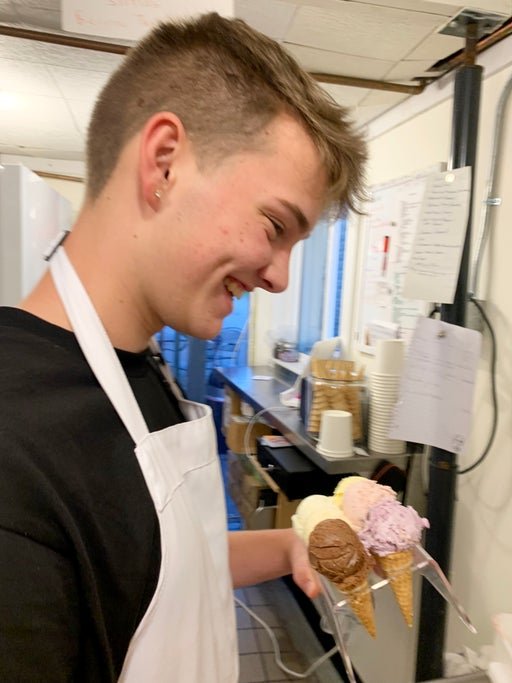Ube: What is This Purple Thing?
What the heck is ube? Ube, a purple yam native to the Philippines, is not only visually stunning but also incredibly delicious. Its unique flavor is sweet, vanilla-y, and nutty. Watch the video to learn a little about it.
Have you had our Ube Heath Bar Crunch ice cream??? Comment and let us know.
Staff Pick: Love on the Spectrum
Ian recommends Love on the Spectrum. It's a show that follows the romantic experiences of young adults who are on the autism spectrum. The show provides a sensitive and insightful portrayal of their journey to find love and navigate relationships. It aims to raise awareness about autism and challenges the stereotypes surrounding people with autism. The focus is on personal growth, emotional connections, and understanding, rather than the typical reality TV drama.
The Fascinating History of Oreos
Our Thai Tea Cookies & Cream, made with Oreos, inspired us to explore their intriguing history. Did you know that 60 billion Oreos are sold every year?
The history of Oreos is a fascinating journey that goes back over a century and reflects the evolution of not only a beloved cookie but also the culture and tastes of consumers around the world. From its humble beginnings to becoming a global phenomenon, the story of Oreos is one of innovation, marketing, and enduring popularity.
Birth of the Oreo: The Oreo cookie was introduced by the National Biscuit Company on March 6, 1912. Originally called the "Oreo Biscuit," the origin of the name remains a subject of debate. Theories range from the French word "or," meaning gold (a nod to the early packaging), to the Greek word "oreo," meaning beautiful, nice, or well-done.
Early Design and Evolution: The original Oreo design featured a wreath around the edge of the cookie and bore the imprint "OREO BISCUIT." This design was altered in 1924 to the familiar embossed design with the word "OREO" and intricate pattern we know today.
Global Expansion and Variations: Over the years, Oreos expanded beyond the United States, gaining popularity internationally. Nabisco introduced various flavor variations and limited-edition releases to cater to diverse tastes, including Mint, Peanut Butter, Golden, and more. The iconic Double Stuff Oreo was introduced in 1975.
Memorable Advertising Campaigns: Oreo’s memorable advertising campaigns have become cultural touchstones. The "Twist, Lick, Dunk" slogan, introduced in the 1990s, encouraged consumers to enjoy Oreos in creative ways. Oreo's Super Bowl blackout tweet in 2013 ("You can still dunk in the dark") demonstrated the brand's ability to engage with pop culture moments.
Oreo's Role in Popular Culture: Oreos have appeared in countless movies, TV shows, and even artwork.
What is the best way to eat an Oreo? Do you twist? Are you team Double Stuff or Team Original?
About to start college? Ian Has Something To Tell You
Ian's worked at Alleyway since since 2018. He's about to be a college sophomore. We're very proud of him.
Everyone's basically in the same boat – nervous and excited with no cliquey groups or friends from high school to cling to. It's a blank slate for everyone. It's crazy how fast you can go from total strangers to feeling like you've known someone forever. You're thrown into these dorms and classes, and suddenly you're talking with anyone who'll listen. It's like a friend hunt, and everyone's a willing participant. Everyone wants connections. There's an unspoken agreement that we're all in this together, trying to build our own little college families. These initial weeks are the foundation, where you can feel the buzz of potential friendships all around campus. It's wild how quickly things can click when nobody's got their own crew yet. So, yeah, we're all nervous, but we're all just going for it. A transformative journey is ahead and it's pretty damn awesome.
Alleyway at Adams, MyTown Marketplace & More
Calcutta Kitchens in Kingston
Julian here. THANK YOU from the bottom of my heart. Your unwavering support is truly unbelievable. Each day, I pour my heart and soul into bringing Alleyway Ice Cream closer to you.
I'm excited to share some wonderful news since our last newsletter. Alleyway Ice Cream is in four new locations, and I'm thrilled to announce that we’ve made our debut in local grocery stores for the first time ever! The new places you can now find our pints are:
Adams in Lake Latrine
MyTown Marketplace in Stone Ridge
Calcutta Kitchens in Kingston
Ruby Hill Farm in Clinton Corners
Alleyway needs your support to make sure our ice cream stays in their freezers. If our ice cream doesn't fly off the shelves, they’re going to take it out to make room for other products. Your love for Alleyway has brought us this far, and I’m counting on you to keep the momentum going. So please, if you see Alleyway in a freezer, buy it! It will help keep our ice cream available for everyone to enjoy.
Staff Pick: One Piece
This week's staff pick comes from Ian who recommends One Piece. Picture a world brimming with colorful characters, epic battles, and boundless imagination. Follow the charismatic and determined Monkey D. Luffy as he leads a group of misfit pirates, the Straw Hat crew, on a daring quest to find the elusive treasure known as the "One Piece." Along the way, they'll encounter mythical islands, fearsome foes, and forge unbreakable bonds that will tug at your heartstrings.
Ian says the sailing is a little unrealistic, "a ship like that would need way more than three sailors." Nevertheless, One Piece is this week's staff pick.
What do you recommend? We'll share it with the staff.
Why Our Matcha Tastes So Good
Here I am in Kyoto drinking matcha, eating matcha ice cream, and matcha tiramisu.
Last December, right after Alleyway closed and Japan finally welcomed tourists back, I got to taste some real matcha for the first time. It was a game-changer and that’s when I realized that Alleyway's matcha needed a serious upgrade. So, I went on a mission and found this amazing matcha straight from Kagoshima. Kagoshima is the best region for organic matcha thanks to the active Sakurajima volcano and nutrient packed volcanic soil. It’s very expensive, but perfect for our ice cream.
What I Learned About Matcha
Matcha’s history goes back at least 800 years with roots in Zen Buddhism. Initially introduced to Japan by Zen monks, the ceremonial preparation and consumption of matcha became an integral part of their meditation practice. The delicate process involves grinding shade-grown tea leaves into a fine powder, which is then whisked into a frothy drink using a bamboo whisk and hot water. This meditative ritual remains alive in traditional tea ceremonies, where every movement is deliberate and imbued with meaning.
Staff Pick: Buddha Bowl
This week's staff pick comes from Madison who recommends Buddha Bowls, a new restaurant coincidentally located in the same building as Alleyway. The menu includes create-your-own bowls with greens, protein, grains, and other toppings as well as signature bowls including the Sweetie Potato, Southwest Chicken, and Greek Salad Bowl. Madison especially likes the Southwest Chicken Bowl.
Buddha Bowls is owned by the same people who own Bluestone Coffee Roasting Company, who also, coincidentally, are my Dad and Stepmom.
What do you recommend? We'll share it with the staff.
What's the deal with Thai Tea?
Here I am in Bangkok at Guss Damn Good ice cream, maybe the only other similarly sized ice cream shop.
The history of tea in Thailand dates back at least four centuries to the reign of King Narai of Ayutthaya. However, tea drinking was only allowed in the capital, at least according to French diplomat Simon de La Loubèr.
De La Loubèr wrote, "Siamese people do not put sugar in their tea and drink it hot, like the Chinese do. It is considered rude to refuse tea; one must take a seat and consume when invited.”
The Indian practice of putting milk eventually traveled to Thailand. Tea was still served hot, but milk and sugar were added. By 1893, Thai entrepreneurs were selling Mam Tun Hua, or sweetened condensed milk and some people began adding it to their tea.
The introduction of ice factories in 1903 led to the popularity of iced tea in shops, eateries, and well-to-do homes during King Rama VI's reign in the 1920s.
The Thai iced tea we know today began in 1945 with the arrival of the ChaTraMue brand. The brand's owner was a Chinese immigrant to Thailand who imported tea from China.
In Thai restaurants, it is served in a tall glass, but when sold from street and market stalls it’s usually poured over the crushed ice in a plastic bag or tall plastic cups.
Recipes for Thai tea have changed over the decades. Some shops use Assam red leaves, some use Ceylon tea, and others use a mix of both. ChaTraMue is still a popular brand, but we use Pantai brand Thai Tea in our Thai Tea Cookies & Cream.
Why is Thai tea orange? The first reason is that the leaves used to make Thai tea are a naturally orange color. These leaves are typically a blend of black tea and Assam tea, which both have a reddish-orange hue. When these leaves are brewed, they release their natural color into the water, giving the tea its signature orange color.
The second reason is that Thai entrepreneurs wanted their tea to stand out from other teas on the market. In the 1940s, when Thai tea was invented, there were many different types of tea available, and it was difficult for Thai entrepreneurs to get their tea noticed. To make their tea stand out, they decided to dye it orange. The orange color was eye-catching and helped to set their tea apart from the competition.
Today, there is still some debate about the true reason for the orange color of Thai tea. Some people believe that the leaves are the primary source of the color, while others believe that the dye is still used. Ultimately, the true reason may never be known. However, one thing is for sure: the orange color of Thai tea is one of its most distinctive features.
Fun fact: I thought of making Thai Tea Cookies & Cream when I was drinking Thai tea in Chiang Mai and noticed a box of Oreos in a store’s window.
Staff Pick: Indiana Jones and the Dial of Destiny
This week's staff pick comes from Nick who recommends Indiana Jones and the Dial of Destiny. He watches an average of three movies per week and has seen everything from Casablanca to Sharknado. Nick loves movies, so you can trust his recs.
What do you recommend? We'll share it with the staff.





